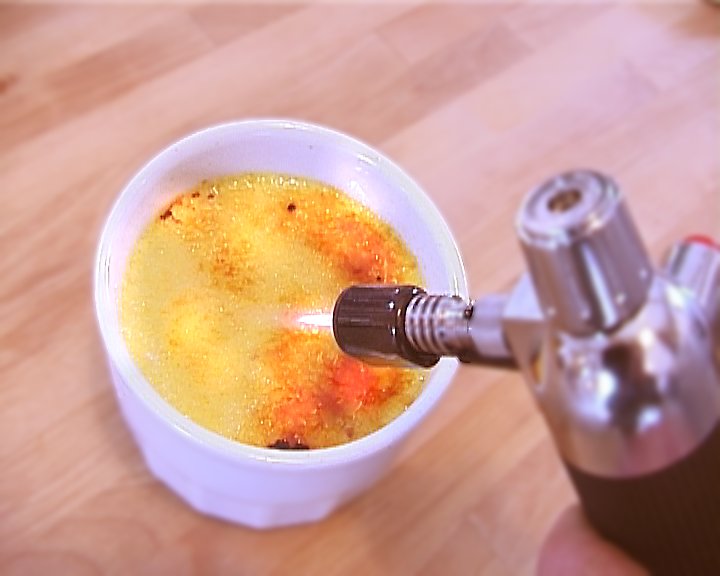Cooking Techniques for Crème Brûlée
On this page you find soms tips and techniques for preparing crème brûlée.
In the Crème brûlée shop you kan buy the utensils needed.
Click here to know more of these utensils and here for more information about the ingredients of crème brûlée.
Baking the Crème Brûlée in the oven
When baking the crème brûlée in a hot water bath, keep the oven on 300° F (150° C).
This will give you a crème brûlée that sets with the right texture, without browning.
If you don't use a hot water bath, but put the crème brûlée directly into the oven, put the oven on 200° F (95° C).
After adding the egg yolks, the cream shouldn't boil anymore.
Place the oven rack just below the middle of the oven, to make sure that the top remains soft.
Use an oven thermometer if you're not sure about the oven temperature.
Heating cream and milk
If you only use cream, you can bring it to the boiling point.
However, don't do so if you added milk to the cream.
You can heat the liquids in a saucepan, but also in glass utensils in the microwave (stir periodically!).
The skin, that forms on the top of the cream when cooling, will be strained out afterwards.
Spicing the cream
The best way to give the cream a delicate flavor, is to add whole spices (or zests) during the scalding process.
Leave it in for about 20 minutes and then go to the next step of the recipe (the spices/zests will be strained out later).
Instead of the traditional vanilla, different spices can be used to give the cream a different flavor.
Thyme and lavender, for example, go well with strawberry, while rosemary can be combined with honey.
|
Mixing egg yolks
When mixing egg yolks and sugar, do not beat, because it will create air bubbles on top of the baked custard.
It is better to mix briskly in a circular motion.
When adding hot cream to the yolk mixture, make sure to add very small amounts at first while stirring continuously, to bring the temperature up slowly.
Straining
Use a fine strainer to sieve the mixture just before pouring it into the ramekins.
To make the filling of the ramekins easier, sieve the crème brûlée into a cup or bowl that has a spout.
Making special sugar for crème brûlée
For a thinner crust with more color and flavor, make a 50/50 mixture of granulated sugar and light brown sugar.
For the light brown sugar to caramelize properly, it should be very dry: put the sugar on baking paper in a baking pan in a low oven (200° F / 95° C) for at least 35 minutes.
It should be crumbly.
After that, cool to room temperature.
If chunks are formed, rub them through a course strainer.
Then mix with the granulated sugar.
If you store the crème brûlée sugar mix in an air-tight container, it can be kept for quite some time.
|
|
Caramelizing crème brûlée
When the custard is ready, it is put in small ramekins to cool.
Just before serving, take the crème brûlée out of the fridge and sprinkle a layer of sugar on top of the custard, as evenly as possible.
Per (4-ounce) ramekin, use between 1 teaspoon and 1 tablespoon of sugar (depending on the form of the ramekins and your own taste).
There are different tools to caramelize the sugar and create the crunchy sweet crust on top of the crème brûlée.
Three of these utensils are discussed below: the culinary torch, the broiler and the iron salamander.
The ideal is to caramelize the top of the crème brûlée without heating up the custard filling below.
In any case: make sure not to burn the sugar/cream!
After caramelizing, you can serve the crème brûlée immediately or, for a more crispy caramel layer, put it back in the refrigerator for 10 minutes (no longer!).
Caramelizing with a culinary torch
Use a small culinary torch. Keep a distance from the flame tip to the sugar that allows for fairly rapid melting without burning instantly.
Keep on moving the torch in small, spiraling circles for gradual caramelizing.
Caramelizing with an iron salamander
The most traditional utensil is the iron salamander. It is still used in good restaurants.
When heated red hot, then slowly swept close above the crème brulee (but not touching the surface!), the salamander sets the crust.
This is extra spectacular, because of the smoke and the smell of burning sugar that come from it.
Make sure to pick ramekins that just fit the salamander.
Caramelizing with a broiler
Caramelizing the top can also be done under the broiler, but it is not a very good idea because the crème brûlée itself will get hot as well.
If the broiler is your only option, put the ramekins in a pan filled with ice cold water.
It takes about 3 minutes to make the crust, keep an eye on it constantly!
|
 The caramelizing of crème brûlée should be gradual: make quick, small, spiraling circles with the torch. The result should be light to medium dark amber.
The caramelizing of crème brûlée should be gradual: make quick, small, spiraling circles with the torch. The result should be light to medium dark amber.
|
|